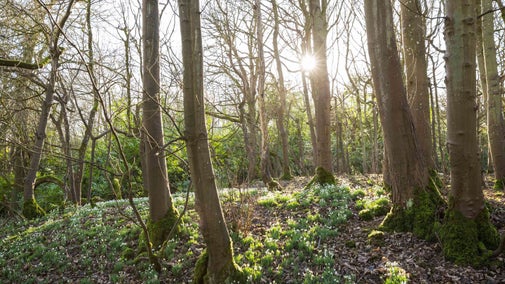
Donate
Everyone needs nature, now more than ever. Donate today and you could help people and nature to thrive at the places we care for.

Nestled in the Cotswold countryside, Lodge Park and the Sherborne Estate are just waiting to be discovered. Immerse yourself in history by exploring Lodge Park's deer park, grandstand, historic collections and the parkland designed by Charles Bridgeman. Venture further onto the Sherborne Estate to enjoy walks, take in the views and spot wildlife including endangered birds and otters.
Lodge Park is England’s only surviving and arguably most opulent 17th century grandstand. Created in 1634 by John ‘Crump’ Dutton, Lodge Park indulged his passion for gambling, banqueting and entertaining.
The building has been modified many times over the years and questions remain about who's responsible for the remodels.
Explore this fascinating building and soak up its rich history. Take in expansive views of the park land surrounding Lodge Park from the balcony, and see how the landscape has changed since the grandstand was first built.
There was already a park here when John 'Crump' Dutton inherited the estate in 1618, but he soon set about enclosing it. A warrant signed by Oliver Cromwell in 1655 allowed him to take bucks and roes from Wychwood Forest to fill this new park. The gentry used to hold brutish deer coursing events here with the grandstand at the centre.
Lodge Park houses the best of the Sherborne collection. Inherited from Lord Sherborne in 1982, its highlights include two chancellor’s chests, Kent furniture and family portraits.
Discover the fascinating architecture of the building, such as the fireplace in the Great Hall, wood panelling and original kitchen features.
In 1726, renowned landscape designer Charles Bridgeman redesigned the parkland at Lodge Park. Although very little of his planting remains today, his designs are still largely intact.
In fact, this is the only surviving Bridgeman landscape not to have been overlaid by the better-remembered designers William Kent and Capability Brown.
Follow the footpaths to the rear of Lodge Park and take in the stunning landscape.

There are three waymarked walking routes to choose from, varying from 30 minutes and 2.5 hours. Leaflets showing the walks can be found in the Ewe Pen Barn, which is situated next to the car park.
Sherborne is a small and scenic village, including a village shop and tea-room (not National Trust). The family walk will take you through the village past the shop, as well as through woodland and parkland.
From the Watermeadows car park there are a series of paths to explore. This area has a lot of wildlife including kingfishers and you may spot signs of an otter visiting too.
Work has nearly finished on improving access on the estate, including improving the paths and waymarking. By the end of the work, the paths will have better surfacing and will be able to be used all year round.
While the team finish these works, diversions will be in place so please follow the signs during your visit.
The Sherborne estate is home to a wide array of wildlife, including raptors and birds.
On the restored 17th century water meadows, a spectacular environment for water birds has been created. Look closely at the rivers and the fields nearby and you'll find lots of common and rare wetland birds – from kingfishers to the occasional osprey – thanks to the work of the ranger team and partners.
If you look closely at the ducks on the rivers you might spot the brown heads of wigeon among the regular mallards. Together with teal, these are winter visitors who add variety to the heron, egrets, swans and other water birds.
Changes in traditional farming techniques and habitat loss means feathered friends have been in rapid decline in many places.
Skylark populations have more than halved since the 1980s and linnets and corn buntings have unfortunately found a place on the red list of endangered birds.
Bucking this downward trend is Sherborne Park Estate, which has shown how sustainable farming can help welcome these traditional birds back to our farmland.
Parts of the estate have been dedicated to creating habitats in which the birds can safely nest, feed and breed. As a result, these species are beginning to make a comeback.
The Sherborne Park Estate is a haven for birds of prey, also known as raptors. The variety of habitats on the estate mean that different species can be seen in different locations.
Wherever you are, the chances are high that you’re being watched by a pair of powerful eyes. Look up at the sky anywhere on the estate and you’re likely to see buzzards or kites soaring overhead.
The river corridors at Sherborne Park are secluded, so there's little disturbance to otters’ habitats. There’s also a good amount of varied bankside vegetation, with plenty of trees and shrubs – the perfect cover for when they want to move around unseen.
The cover also allows opportunities for underground holts (an otter home) between roots, as well as above ground areas called ‘couches’ where otters rest during the day.
Water vole numbers have been declining even more drastically than otters in recent years. However, thanks to habitat conservation work, Sherborne’s water vole population is booming – but they are very tricky to spot.
Spring and early summer are the best times of year for seeing a water vole. At this time, there is less vegetation growth meaning that – in theory – they should be easier to see.
Looking along the banks for their burrows or signs of feeding and droppings will give away their territory.
Working for the benefit of wildlife and people, the Big Nature, Better Access Project is a unique opportunity to realise a vision for Sherborne that includes nature recovery, climate resilience and inclusive access to the landscape. Much of our work at Sherborne Estate is focussed on this project and you can see how it is tranforming the landscape through tree planting at Sherborne Farm and on the Bridgeman Landscape and through the restoration of many miles of traditional Cotswold drystone wall. View more about the Big Nature, Better Access Project here.

Everyone needs nature, now more than ever. Donate today and you could help people and nature to thrive at the places we care for.
Although much of the original landscape at Lodge Park has now been lost, there are still plenty of clues as to what may have looked like in the past. The designs, created by the gardener Charles Bridgeman, was considered revolutionary at the time.

The landscape at Lodge Park was designed by Charles Bridgeman in the 18th century, but it was never completed. Now, almost 300 years later, work has begun to restore the design.
Plan a visit to one of the special countryside places in our care and discover the benefits of being in the great outdoors. Pack your walking boots and get ready to explore woodlands, valleys and rivers.

Explore some of the finest landscapes in our care on coastal paths, accessible trails, woodland walks and everything in between. Find the best places to walk near you.

Explore some of the finest landscapes in our care on coastal paths, accessible trails, woodland walks and everything in between. Find the best places to walk near you.
